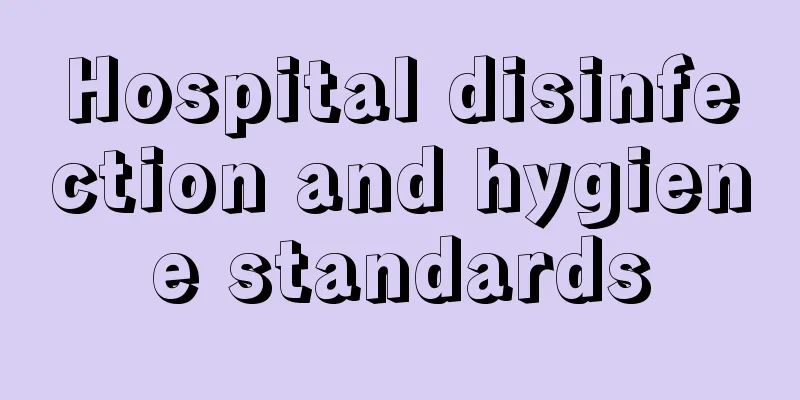Hospital disinfection and hygiene standards

|
We all know that hospitals are places full of patients. Correspondingly, there are also a lot of bacteria in hospitals. This is why many friends are reluctant to go to hospitals for fear of contracting diseases. In fact, as a place to treat diseases, hospitals must have protective measures, such as disinfection. So, what are the hospital disinfection and hygiene standards? Let us all learn about this knowledge together. In fact, the disinfection and hygiene standards of hospitals are very high. If there are no strict standards, the hospital will become a source of infection, which is not allowed. The hospital's disinfection system standards are as follows, which we can learn from. Hospital environment cleaning and disinfection system 1. The rags used in the treatment room, dressing room, office, etc. should be used separately and must not be mixed. After use, soak it in 500mg/L chlorine-containing disinfectant for 30 minutes, then rinse it with clean water and dry it for later use. When in use, wipe and disinfect with 500mg/L effective chlorine disinfectant. 2. Bed rag (small towel): Use one bed and one towel for wet cleaning. After use, soak and disinfect in 500mg/L effective chlorine disinfectant for 30 minutes, wash clean, dry and set aside. 3. Mops: They should be clearly marked and used in strict accordance with the following areas: ⑴ Mops in general wards, offices, treatment rooms, and dressing room corridors should be rinsed with clean water after each use and hung to dry for later use. ⑵ When there is blood, secretions or excrement on the floor of wards, treatment rooms, dressing rooms, etc., first pour an appropriate amount of 1000mg/L effective chlorine disinfectant on the contaminated floor for 30 minutes, then mop it clean. Soak the mop in 500mg/L effective chlorine disinfectant for 30 minutes, then wash it clean, dry it and set it aside. ⑶ Infectious disease areas should be disinfected after use. Soak them in 1000mg/L effective chlorine disinfectant for 30 minutes, then rinse them with clean water, and then soak them in 500mg/L effective chlorine disinfectant for 30 minutes, and hang them to dry for later use. 4. Disinfection of the ground: ⑴ When there is no obvious contamination on the ground, wet cleaning is usually adopted, and the floor is mopped with clean water or detergent 1-2 times a day. ⑵ When the ground is contaminated by pathogenic bacteria, use 500mg/L of effective chlorine for disinfection for 30 minutes. If it is contaminated by pathogenic spores, mop or spray the ground with 1000mg/L disinfectant. 5. The tables, chairs, stools, bedside tables, etc. in the ward generally only require daily cleaning and sanitation, and should be wiped twice a day with a clean wet cloth. When contaminated by pathogens, wipe or spray the surfaces of various objects in the room with 500 mg/L of effective chlorine for disinfection. After reading the above introduction to hospital disinfection and hygiene standards, I believe everyone should now have some understanding of the hospital disinfection standards. In life, those of us who are afraid of being infected by hospital viruses may wish to read the above introduction. In this way, I believe everyone should no longer be timid about hospitals. |
Recommend
The difference between ovarian granulosa cell tumor and ovarian cancer
Ovarian granulosa cell tumor and ovarian cancer h...
Does it hurt to remove the stitches after double eyelid surgery?
Double eyelid surgery and canthoplasty surgery ar...
The big toe is swollen and painful for no reason
Severe big toe pain can interfere with daily life...
What are the symptoms of early prostate cancer
In the early stage of prostate cancer, patients c...
What are the taboos when taking a newborn home
There are sometimes many taboos when you have a b...
Five tips to keep away sleepiness in summer
As the saying goes, "Spring makes you sleepy...
How to clean new tea sets before use?
Many people like to drink tea. We all know that d...
What is the use of dental floss
Many people feel that there are a lot of food res...
What to do if sinusitis recurs
Many patients have expressed that they are prone ...
What are the preventive measures for bladder cancer
The most important aspect of preventing bladder c...
What are the effects of compound sulfur lotion
In life, many people will suffer from some skin d...
What aspects are included in postoperative nursing for lung cancer? Introduction to six nursing measures after lung cancer surgery
Generally speaking, the digestive function of pat...
How to make corn dumplings
The taste and nutritional value of corn are outst...
Is it good to train muscles at night?
It is okay to exercise your muscles at night, but...
How to strengthen the spleen and stomach most effectively
Traditional Chinese medicine believes that the ki...









